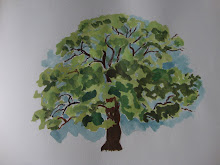
I live in what was once a nice quaint place known for its ‘nawabi culture' . People were polite and courteous. And unlike a bustling metropolis like Bombay ( as it was known then) our small city had a laid-back attitude where life was slow-paced and considered an ideal place to retire. But, now, that is debatable.
It could have been the migration of people from other areas. We suddenly had a new set of inhabitants who were aggressive and brash. And in no time, it seemed, the city embraced not just the people, but their habits as well. And now, every rule is broken with utter disregard, the courteous nature has disappeared, the thugs – it could be the locality hooligan, the roadside ruffian or the political heavyweight - but they are all there throwing their weight around.
Traffic rules are no longer observed. People speed recklessly, go through the red signal at intersections, drive on the wrong side of the street. Construction workers dump their rubble, bricks, cement on the road. Litter is strewn on the streets. As a conscientious citizen if you as much as stop and question any of them, they are quick to retaliate.
Where are we heading?
Ulrich of the U of Texas, states that that small acts of disrespect and lawlessness are the kind of behavior that could easily be reformed. Superficially it may appear to be a minor infraction but is actually a small act of anarchy. Even a traffic violation is lawless in the sense that it is carried out in defiance of the law. It entails an attitude towards the rules of society not merely the legal rules but also the lesser guidelines that have been tacitly established by society to enable us all to live in close proximity without hostility . The lawless are openly scornful of these rules, and when they act according to their inclinations, they attack, even if inadvertently, the very fabric of our civilization.
It thus seems that lawlessness spreads via small acts and it may be more important to tackle these than to concentrate only on the seemingly big problems.
It is this very concept that is the focus of the Broken Window Theory by George L. Kelling and Catherine Coles . A successful strategy for preventing vandalism, they say is to fix the problems when they are small. Repairing broken windows in a building within a short time, will reduce the risk of vandals breaking more windows and doing more damage. By cleaning up the sidewalk every day, the tendency for litter not to accumulate is lessened. Problems thus do not escalate and the neighborhood is more likely to have respectable inhabitants.
Unfortunately, not much is being done in this direction and at times it seems that this state of lawlessness has lead to a situation where perpetrators of petty crimes are viewed with sympathy. A news report appeared in the papers last week. A fatal accident occurred in our neighbourhood. The victims were on a two wheeler that was moving on the wrong side of a one way street when they were struck down by a vehicle . The report stated that a case was registered against the driver of the vehicle that knocked down the persons on the two wheeler for reckless and negligent driving. It was regrettable that lives were lost, but strange that action was being taken against a person who unfortunately was involved in an accident that was not his doing. And he was not breaking any law!
BN Harish, an advocate in Chennai writing in the aftermath of the Mumbai attacks also stresses on this topic. He says, we seem to be heading into a state of lawlessness, not just that of the external terrorist attacks , but that of lawlessness of our own making. If our governing institutions are not used to, or know how to carry out their duties properly on a day-to-day basis in times of calm and peace, is it surprising that they are found wanting in times of crisis? Law enforcement cannot make a distinction between 'our' goons and 'their' goons. It has to make a distinction between goons and law abiding citizens. We need to start respecting the law and internalise the integrity needed for the governance for this country.
And if no corrective steps are taken now, we will be at a point of no return.
So, where are we are heading?




